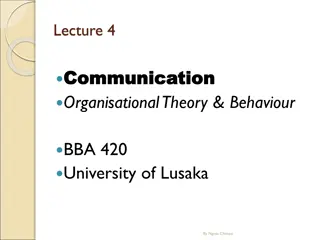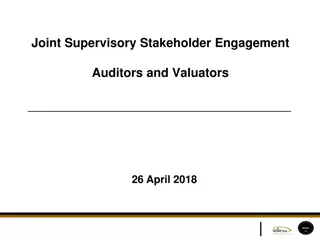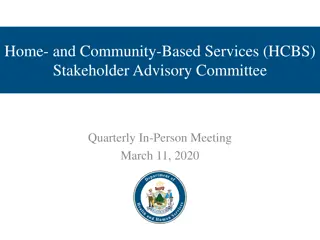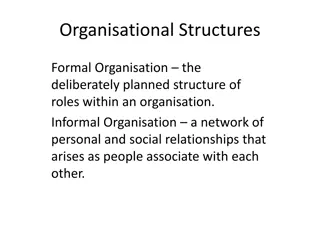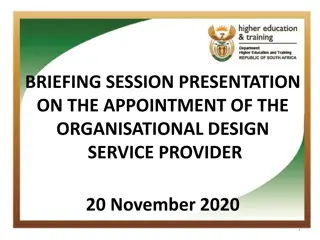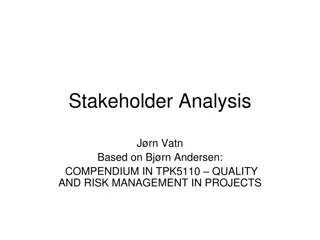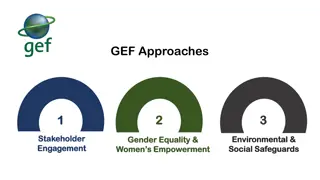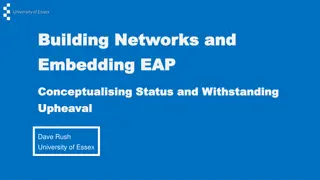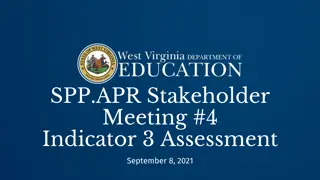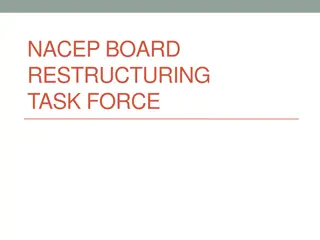NAMFISA Stakeholder Engagement and Organisational Restructuring Update
NAMFISA, established by an Act of parliament, focuses on supervising financial institutions and services, advising the Minister of Finance, and ensuring compliance. The regulatory ambit includes various sectors like long-term insurance, pension funds, and more. The team includes heads for prudential supervision, with a recent organizational restructuring to optimize resources and enhance efficiency. The new structure, effective from April 2018, includes separate streams for prudential supervision and market conduct, each led by a Deputy CEO.
- NAMFISA
- Stakeholder Engagement
- Financial Regulation
- Organisational Restructuring
- Prudential Supervision
Download Presentation

Please find below an Image/Link to download the presentation.
The content on the website is provided AS IS for your information and personal use only. It may not be sold, licensed, or shared on other websites without obtaining consent from the author. Download presentation by click this link. If you encounter any issues during the download, it is possible that the publisher has removed the file from their server.
E N D
Presentation Transcript
Board of Directors and Board of Trustees Stakeholder Engagement Session 16 April 2018 |
Introduction// Establishment NAMFISA was established by an Act of parliament, NAMFISA Act 3 of 2001 with the object to:- exercise supervision over the business of financial institutions and financial services; Advise the Minister of Finance matters related to financial institutions and services; Enforce Compliance with Financial Intelligence Act |
Current Regulatory ambit //- Regulatory Scope Long-term Insurance Micro Lenders (Usury) Short-term Insurance Participation Bonds Medical Aid Funds NAMFISA Stock Exchange Pension Funds Unit Trusts SPVs and UIMs Friendly Societies |
Current Regulatory ambit //- Regulatory Scope Size of the Regulated Financial Sector as at 31 December 2017 No. of Institutions No. of Intermediaries Assets (N$ billion) Assets (N$ billion: 2016) Sector Pension Funds 138 - 152.89 133.09 Friendly Societies 1 - 0.01 0.01 Medical Aid Funds 10 1 1.80 1.45 Long-Term Insurers 17 4,998 54.00 40.70 Short-Term Insurers 14 1,455 6.23 5.80 CIS 14 - 55.92 48.31 Capital markets 34 - 164.28 150.10 UIMs and SPVs 40 - 2.90 2.37 Microlenders 317 - 5.46 4.22 TOTAL 586 6,454 443.49 386.05 |
TEAM// Prudential Supervision Heads Kenneth Matomola Chief Executive Officer Erna Motinga Deputy CEO: Prudential Supervision Grace Mohamed GM: Insurance & Medical Aid Funds Lovisa Indongo-Namandje GM: Pension Funds & Friendly Societies Floris Fleermuys GM: RPS Evangelina Nailenge GM: Capital Markets |
TEAM// Organisational Restructuring NAMFISA embarked on an organisational restructuring exercise in order to Optimise resources; Maximise efficiencies; Enhance focus on our core mandate and Ensure prudent financial management. The new structure groups all prudential supervisory divisions under one stream and has a separate stream for market conduct and operations. Each stream is be headed by a Deputy Chief Executive Officer. The new structure became effective on 1 April 2018. |
TEAM// Organisational Restructuring NEW STRUCTURE CEO DCEO: Market Conduct & Operational DCEO: Prudential Supervision GM: Pension Funds & Friendly Societies GM: Insurance & Medical Aid Funds Manager: Corporate Communication GM: Market Conduct GM: Capital Markets GM: Legal Services GM: RPS Head: GRC GM: Finance and Admin GM: ICT GM: HR |
TEAM// MARKET CONDUCT DIVISION GM: Market Conduct Manager: Microlending & Intermediaries Manager: Inspections & AML Manager: Consumer Complaints & Education Manager: Licensing & Registration |
TEAM// LICENSING & REGISTRATION The most significant alteration is the introduction of a Licensing and Registration department. The Licensing and Registration department will be responsible for, amongst others: Registration of Financial Institutions and Intermediaries; Deregistration (Initiated); Deregistration (Voluntary); Approval of appointments of certain Key Persons (i.e. POs, Auditors, Valuators etc.); Name Reservations and Changes, Transfer of Shareholding; and Issuance of Certificates of Good Standing. |
Proposed Legislative reforms //- Bills status Proposed Bill Status Financial Institutions and Markets (FIM ) Bill Supported by subordinate legislation e.g. Regulations and Standards Final draft available on the NAMFISA website o Final draft of the FIM Bill submitted to MOF by MOJ during September 2017 NAMFISA Bill To be sent to the Attorney-General for certification, via the Cabinet and then onwards to National Assembly o Final draft available on the NAMFISA website Financial Services Adjudicator (FSA) Bill Final draft available on the NAMFISA website |
Proposed Legislative reforms //- Bills status Proposed Bill Status Microlending Bill Supported legislation e.g. Regulations and Standards Final draft o Tabled in Parliament on 22 February 2018 by subordinate available on the NAMFISA website Consumer Credit Bill o Necessary research will be conducted in due course for purposes of framing a policy document o Policy document will form the basis of the Consumer Credit Bill |
Proposed Legislative reforms //- Standards and Regulations Status of Standards and Regulations First Phase Standards and Regulations Informal consultations held with industry during 2015 Submitted to Ministry of Finance for certification. Formal public consultation to commence once FIM is promulgated Second Phase Standards and Regulations Draft Standards were distributed to industry for comment during 2017 Comments from industry were addressed Third Phase Standards and Regulations Drafting is spread over next 3 financial years, having regard to priority of particular Standards and Regulations |
FIM Bill //- New Governance requirements for Boards Boards of financial institutions: Board members must be fit and proper Minimum number of meetings of board to be held per year Certain persons not to be appointed as board members Specific reporting requirements imposed on board members Specific requirements pertaining to independence of board members Requirement to establish audit committee Board members to comply with duty of care provisions, requiring that they take account of interests of stakeholders, act honestly and in good faith, etc. |
FIM Bill //- New Governance requirements for Boards Boards have the duty to, inter alia: Ensure that members interests are protected Ensure that the entity complies with the Act and applicable rules Act with due care, diligence, prudence and good faith Avoid/manage conflicts of interest where applicable Ensure the appropriate management of risks Ensure the timeous payment of contributions to the entity Obtain expert advise where there is lack of expertise within the board Ensure that the board meets as often as is required Monitor the performance of the administrator of the entity |
FIM Bill-//- Supervision Supervision -ensuring approved persons comply with the rules. NAMFISA directly supervises level A approved persons. Level A approved persons supervise level B approved persons, while NAMFISA retains indirect oversight. Enforcement - taking action against non-compliers to impose conditions or administrative penalties or to withdraw approval: by NAMFISA against level A approved persons; by level A approved persons against level B approved persons; by NAMFISA against level B approved persons where level A approved persons fail to take appropriate action or to react to a complaint. |
INSPECTIONS -//- Supervisory Ladder of Intervention No. entities of % of total entities Stages Remarks Stage 1 (no significant problems) 62% 361 13% Stage 2 (early warning) 76 Generally all sectors are sound. continues to engage the entities on non-compliance issues. Micro lending & Pension Funds contribute significantly to stage 5 entities Stage 3 (risk to viability or solvency) NAMFISA 7% 43 Stage 4 (future viability in serious doubt) 5% 30 sectors Stage 5 (entity not viable or solvency imminent) 13% 75 Total 585 100% |
INSPECTIONS -//- Supervisory Ladder of Intervention Pension Funds & Friendly societies CIS (incl. UIM & SPV) Supervisory interventions stages Medical Aid Funds Long- term Insurance Capital Market s Short- term Insurance MLCA Total Stage 1 no significant problems Stage 2 early warning Stage 3 risk to viability or solvency Stage 4 future viability in serious doubt Stage 5 entity not viable or solvency imminent 68 3 4 8 50 200 28 361 11 3 5 6 2 48 1 76 5 2 3 3 0 28 2 43 0 2 0 0 0 26 2 30 55 0 2 0 2 15 1 75 |
INSPECTIONS -//- Key FindingsFIA Compliance Inadequate / Absence of risk management process on money laundering/terrorism financing/proliferation of financing risks; Inadequate customer due diligence ( CDD) information; Inadequate or ineffective account and transactions and activities; Non reporting of suspicious transactions and activities; Non reporting of cash transactions above thresholds; Inadequate scope for independent audit function to evaluate effectiveness of controls; Inadequate Staff training and awareness on AML/Combating financing of terrorism /Combating Proliferation of finance No progress in addressing the findings highlighted in previous compliance assessments |
INSPECTIONS -//- Key Findings INSURANCE Insurers Board Compositions not in accordance with the principles of good corporate governance i.e independent vs non independent Key control functions outsourced Employing unregistered intermediaries (brokers and agents) & intermediaries outside of Namibia Centralization of key control functions at group level Insurance intermediaries Lack of knowledge of the Act(s) Provision of AFS as required Maintaining Licensing Requirements |
INSPECTIONS -//- Key Findings PENSION FUNDS Non-compliance to the Pension Funds Act; Constitution of the Board of Trustees not in accordance with the rules of the Fund; Long serving service providers and familiarity risk to independence; Fund operating under expired subscription agreements with Special Purpose Vehicles as drawdown period of 24 months as provided in the Act has lapsed without commitments being (fully) drawndown; Failure to conduct performance appraisals for the Board of Trustees and the Principal Officer; The absence of policy documents or adequate Service Level Agreements with service providers |
INSPECTIONS -//- Key Findings MEDICAL AID FUNDS Constitution of the Board of Trustees not in accordance with the rules of the Fund; Fund Rules not explicitly defining a criteria for granting contribution premium discounts. Funds rules not stipulating the number of times that Trustees may be re- elected. No performance appraisals for the Board and the Principal Officer; The absence of policy documents and deficiencies identified in some policy documents Provision of inaccurate quarterly information. Inconsistencies between the Board of Trustees meetings register and the minutes records. |
INSPECTIONS -//- Key Findings UIMs, SPVs, UNIT TRUSTS, INVESTMENT MANAGERS Registrar not notified of changes in directorship, portfolio managers and other key persons; No documented Business Continuity Plans in place; Unsigned Board Charters Lack of documented board minutes and resolutions Independent directors not in the majority at some Board Meeting to review key decisions such as investments as requirement by the law Lack of documented operational policies in place No proof of risk mitigating factors in place for offshore foreign investments. Inconsistency in figures reported in AFS versus quarterly submissions Some entities had no compliance officer in place |
INSPECTIONS -//- Key Findings MICROLENDERS Non-adherence to the prudent loan disbursement guidelines of NAMFISA Key responsible persons (KRPs) had little or no knowledge of the Financial Intelligence Act No.13 of 2012 and the requirements thereof. Approved Principal Officers were not in the full-time employment of the Cash Loan business contrary to NAMFISA s requirements in this regard Non-submission of returns and the payment of levies. |
INSPECTIONS -//- Key Findings MICROLENDERS (CONT) Non-subscription to a registered credit bureau. Retention of Bank Cards and PINs and original IDs as security for loans; Microlenders were conducting parallel activities, without NAMFISA s prior approval. No affordability checks performed, absence of pay slips and bank statements Incidence of loan roll-overs where capital is rolled-over on a monthly basis and only the interest serviced Absence of a proper accounting system. Absence of a proper loan administration program |
INSPECTIONS -//- Joint Inspections NAMFISA will once again conduct joint inspections during the 2018/2019 financial year. The objectives of the joint supervision exercise are to: Reduce any supervisory gaps and avoid unnecessary supervisory duplication by establishing supervisory plan for the group across Divisions. Enhance the effectiveness and efficiency of the supervisory process by providing a platform for stronger coordination, whereby supervisory staff members can reach agreements on key supervisory tasks and activities, such as inter alia, the exchange of information, voluntary sharing and delegation of work, and acquiring a common understanding of the risk profile for the group. Minimise the risk of contagion through the development of a shared understanding of the group and its risk profile by members of the internal college structure. |
INSPECTIONS -//- Joint Inspections The theme of the joint inspections is governance and risk management. It is commonplace in the financial sector for financial entities to create groups that provide complementary services to the market. However, it must be stressed that governance requirements apply to individual regulated entities as opposed to groups which are not regulated. Thus compliance with requirements and / or best practice will be assessed in relation to individual entities as opposed to groups. |
Meet the Boards -//- End Questions |








